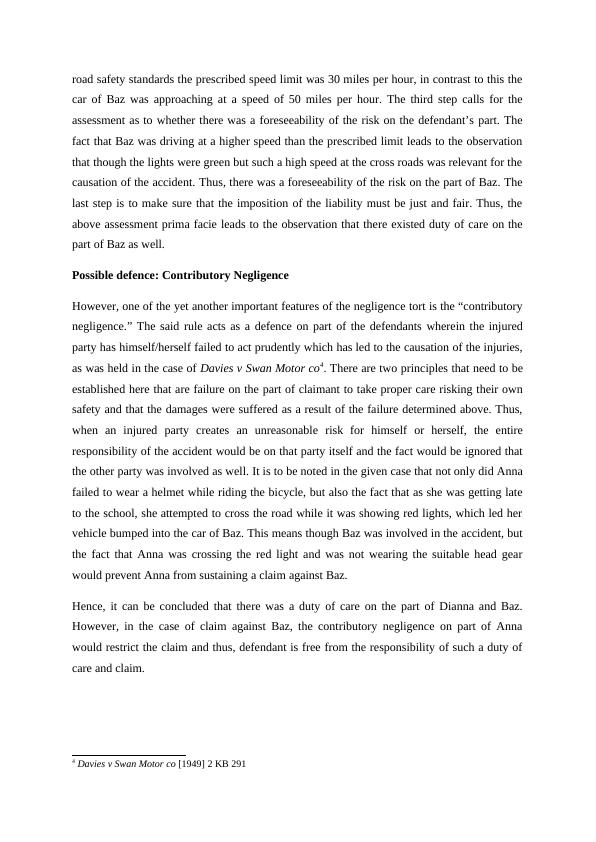Case Study On the Law of Tort
Added on 2022-08-18
7 Pages2063 Words10 Views
BUSINESS LAW
TORT LAW
TORT LAW

Law of Tort – Problem Question
The issue in the given case study is to analyse whether a tort claim can be succeeded on the
part of Anna against Baz and Diana under the negligence conduct. In order to establish the
tort law claim, the various aspects of Negligence would be examined. These are the existence
of the duty of care on the part of the defendants, the violation of such duty of care and that
the damages that were sustained were the direct result of the breach of the above assessed
duties, and thus the defendants Baz and Diana indulged into negligent conduct. On the other
hand, the defendants can succeed in avoiding the liability by proving that one or more of the
above elements were missing.
Existence of Duty of Care
Negligence tort is a branch of tort law which focuses on the negligent conduct of the parties.
The negligent conduct denotes a situation wherein an individual has indulged into omissions
in acting thus has not acted in a manner a reasonably prudent person would have done in the
given situation1. There existed a duty to care on part of the defendants is the prime condition
to be proved to successfully establish the negligence claim. As pronounced in the renowned
case of Caparo Industries plc. Vs. Dickman2, in order to establish whether there existed a
duty of care or not, the three step test must be satisfied. However, the said test need not be
applied where there is a proximate relationship between the parties as mentioned in the legal
provisions of tort law. In the given case study, there are three parties. While a proximate
relationship exists between Dianna and Anna by the virtue of being the doctor and the patient,
the Caparo test needs to be applied in case of Baz and Anna.
The three steps in the Caparo test are elaborated as follows. The first step calls for the
assessment of the proximate relationship which does not simply mean the proximity in
physical manner, but means the legal proximity. The fact that both Baz and Anna were
driving on the road, both had a physical as well as the legal proximity in terms of the road
users. It is to be noted that as per the general rule of the law, a road user owes a duty to care
towards all the other road users3. As per the second step of the test it is to be seen whether
defendants engaged in the acts which led to the establishment of the risk or the increment of
the same that further led to the harm. In the given case study it is to be noted that as per the
1 Kirsty Horsey and Erica Rackley, Tort Law (4th edn, OUP 2015) 38-39.
2 Caparo Industries pIc v Dickman [1990] 2 AC 605
3 'What Are The Duties Of Road Users? | Truth Legal Solicitors' (Truth Legal Solicitors, 2018)
<https://www.truthlegal.com/what-are-the-duties-of-road-users/> accessed 11 March 2020.
The issue in the given case study is to analyse whether a tort claim can be succeeded on the
part of Anna against Baz and Diana under the negligence conduct. In order to establish the
tort law claim, the various aspects of Negligence would be examined. These are the existence
of the duty of care on the part of the defendants, the violation of such duty of care and that
the damages that were sustained were the direct result of the breach of the above assessed
duties, and thus the defendants Baz and Diana indulged into negligent conduct. On the other
hand, the defendants can succeed in avoiding the liability by proving that one or more of the
above elements were missing.
Existence of Duty of Care
Negligence tort is a branch of tort law which focuses on the negligent conduct of the parties.
The negligent conduct denotes a situation wherein an individual has indulged into omissions
in acting thus has not acted in a manner a reasonably prudent person would have done in the
given situation1. There existed a duty to care on part of the defendants is the prime condition
to be proved to successfully establish the negligence claim. As pronounced in the renowned
case of Caparo Industries plc. Vs. Dickman2, in order to establish whether there existed a
duty of care or not, the three step test must be satisfied. However, the said test need not be
applied where there is a proximate relationship between the parties as mentioned in the legal
provisions of tort law. In the given case study, there are three parties. While a proximate
relationship exists between Dianna and Anna by the virtue of being the doctor and the patient,
the Caparo test needs to be applied in case of Baz and Anna.
The three steps in the Caparo test are elaborated as follows. The first step calls for the
assessment of the proximate relationship which does not simply mean the proximity in
physical manner, but means the legal proximity. The fact that both Baz and Anna were
driving on the road, both had a physical as well as the legal proximity in terms of the road
users. It is to be noted that as per the general rule of the law, a road user owes a duty to care
towards all the other road users3. As per the second step of the test it is to be seen whether
defendants engaged in the acts which led to the establishment of the risk or the increment of
the same that further led to the harm. In the given case study it is to be noted that as per the
1 Kirsty Horsey and Erica Rackley, Tort Law (4th edn, OUP 2015) 38-39.
2 Caparo Industries pIc v Dickman [1990] 2 AC 605
3 'What Are The Duties Of Road Users? | Truth Legal Solicitors' (Truth Legal Solicitors, 2018)
<https://www.truthlegal.com/what-are-the-duties-of-road-users/> accessed 11 March 2020.

road safety standards the prescribed speed limit was 30 miles per hour, in contrast to this the
car of Baz was approaching at a speed of 50 miles per hour. The third step calls for the
assessment as to whether there was a foreseeability of the risk on the defendant’s part. The
fact that Baz was driving at a higher speed than the prescribed limit leads to the observation
that though the lights were green but such a high speed at the cross roads was relevant for the
causation of the accident. Thus, there was a foreseeability of the risk on the part of Baz. The
last step is to make sure that the imposition of the liability must be just and fair. Thus, the
above assessment prima facie leads to the observation that there existed duty of care on the
part of Baz as well.
Possible defence: Contributory Negligence
However, one of the yet another important features of the negligence tort is the “contributory
negligence.” The said rule acts as a defence on part of the defendants wherein the injured
party has himself/herself failed to act prudently which has led to the causation of the injuries,
as was held in the case of Davies v Swan Motor co4. There are two principles that need to be
established here that are failure on the part of claimant to take proper care risking their own
safety and that the damages were suffered as a result of the failure determined above. Thus,
when an injured party creates an unreasonable risk for himself or herself, the entire
responsibility of the accident would be on that party itself and the fact would be ignored that
the other party was involved as well. It is to be noted in the given case that not only did Anna
failed to wear a helmet while riding the bicycle, but also the fact that as she was getting late
to the school, she attempted to cross the road while it was showing red lights, which led her
vehicle bumped into the car of Baz. This means though Baz was involved in the accident, but
the fact that Anna was crossing the red light and was not wearing the suitable head gear
would prevent Anna from sustaining a claim against Baz.
Hence, it can be concluded that there was a duty of care on the part of Dianna and Baz.
However, in the case of claim against Baz, the contributory negligence on part of Anna
would restrict the claim and thus, defendant is free from the responsibility of such a duty of
care and claim.
4 Davies v Swan Motor co [1949] 2 KB 291
car of Baz was approaching at a speed of 50 miles per hour. The third step calls for the
assessment as to whether there was a foreseeability of the risk on the defendant’s part. The
fact that Baz was driving at a higher speed than the prescribed limit leads to the observation
that though the lights were green but such a high speed at the cross roads was relevant for the
causation of the accident. Thus, there was a foreseeability of the risk on the part of Baz. The
last step is to make sure that the imposition of the liability must be just and fair. Thus, the
above assessment prima facie leads to the observation that there existed duty of care on the
part of Baz as well.
Possible defence: Contributory Negligence
However, one of the yet another important features of the negligence tort is the “contributory
negligence.” The said rule acts as a defence on part of the defendants wherein the injured
party has himself/herself failed to act prudently which has led to the causation of the injuries,
as was held in the case of Davies v Swan Motor co4. There are two principles that need to be
established here that are failure on the part of claimant to take proper care risking their own
safety and that the damages were suffered as a result of the failure determined above. Thus,
when an injured party creates an unreasonable risk for himself or herself, the entire
responsibility of the accident would be on that party itself and the fact would be ignored that
the other party was involved as well. It is to be noted in the given case that not only did Anna
failed to wear a helmet while riding the bicycle, but also the fact that as she was getting late
to the school, she attempted to cross the road while it was showing red lights, which led her
vehicle bumped into the car of Baz. This means though Baz was involved in the accident, but
the fact that Anna was crossing the red light and was not wearing the suitable head gear
would prevent Anna from sustaining a claim against Baz.
Hence, it can be concluded that there was a duty of care on the part of Dianna and Baz.
However, in the case of claim against Baz, the contributory negligence on part of Anna
would restrict the claim and thus, defendant is free from the responsibility of such a duty of
care and claim.
4 Davies v Swan Motor co [1949] 2 KB 291

End of preview
Want to access all the pages? Upload your documents or become a member.
Related Documents
Elements of Negligence Case Study 2022lg...
|8
|2027
|30
Legal Aspect of Responsible Leadership: Analysis of Negligence Tort and Alternative Dispute Resolution Methodslg...
|8
|2440
|230
Tort Law: Establishing Negligence and Defense of Volenti Non Fit Injurialg...
|9
|2482
|62
Negligence and Pure Economic Loss in Construction: A Case Study Analysislg...
|10
|2398
|112
Analysis of Negligence Liability in the Case of Cliff and Mary vs Susanlg...
|7
|2264
|195
Principles of Commercial Law: Negligence and Duty of Carelg...
|7
|2211
|1
